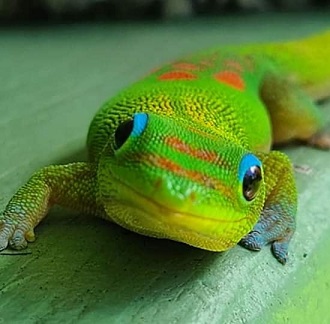Trinidad Blindsnakes - Amerotyphlops trinitatus - reptilenesia
Trinidad Blindsnakes, Amerotyphlops trinitatus
TRAITS. These snakes resemble earthworms and have light pink heads, with a small mouth and
barely noticeable eyes under their scales (Fig. 1). Amerotyphlops trinitatus averages about 24cm
in body length or snout-vent-length (SVL). Its tail measures about 1.2% of its SVL, which is
short and stumpy compared to other snakes, with a thin sharp spine at the tip of its tail (Fig. 2)
and a short tongue. These snakes have short heads, with rounded snouts and smooth, round
scales covering their entire body and head (Fig. 3). This snake has 345 ventral scales, 14
subcaudals (below the tail), and 24 rows of mid-body scales.
DISTRIBUTION. Amerotyphlops trinitatus is mainly found in South America; in Brazil, Peru
and Guyana, and in both Trinidad and Tobago.
HABITAT AND ECOLOGY. This species is found in many different environments such as a
dry forests as well as rainforests and low coastal lands. Another common name for this species of
snake is the Trinidad burrowing snake because it prefers to live under the soil and loose leaves,
that is, in subterranean and soil environments. The Trinidad blind snake is a carnivore, its diet is
mostly composed of ants and their larvae and pupae. Trinidad blind snakes are rarely seen or
collected since they live mostly in isolation, underground, avoiding human interaction. They are
nocturnal since most of their hunting and other activity occurs in the night. Amerotyphlops
trinitatus is oviparous; this means that these snakes lay eggs, but there is no information
available about how many eggs they lay and how often they reproduce.
BEHAVIOUR. The Trinidad blind snake lives under soil, leaves, logs and rocks and therefore
has little to no interaction with other living organisms besides their prey. If a human attempts to
hold this snake, it will squirm and twist to loosen the grip on it. This is a defensive mechanism.
Very little is known of their natural history except that they are insect eaters.
APPLIED BIOLOGY. These snakes are not listed as an endangered or threatened species,
however there is very little information on their numbers in the wild, their abundance and life
span.
Size. 237 mm SVL, total length 240 mm. Tail about 1.2% of SVL.
Identification. Rostral visible from above; snout projects over the mouth; nasals divided; no loreal; a single small preocular contacts upper labials 2–3; four upper labials; third and fourth labials similar in size, both taller than long; ocular scale small; dorsal scales from rostral to tail-spine number 388–389; subcaudals in 10 rows; 20 scale rows around mid-body; dorsal pattern of 11–13 dark brown stripes; the yellow head and tail spots make it difficult to distinguish one end from the other.
Similar Species: Epictia tenella has 14 scales around the body. Ameroyphlops cf. brongersmianus has a larger diameter body, the pattern is uniform, not striped, and it has a complete nasal cleft. The undescribed anomalepidid also has a yellow-tipped head and tail, but has 18 scale rows at mid-body.
Distribution. Trinidad and Tobago.
Habitat. A forest and forest-edge species likely to be found in rotting logs, leaf litter, and loose soil. This species has been listed as critically endangered because many of its known locations are under or near development projects. However, it has been recently found in the Main Ridge Forest Reserve on Tobago. It is associated with Three-lined Snake and Hex-scaled Bachia in ant and termites nest associated with decomposing logs and vegetation.
 |
| Pair in copula. |
Biology. Active any time of day. The diet includes ants and termites. We observed copulation in June and one female contained seven or eight eggs.
REFERENCES
Boos, H. E.A. (2001). The Snakes of Trinidad and Tobago. Texas A&M University Press, College Station.
Gale, T. (2005). Early Blind Snakes: Anomalepididae. Grzimek's Student Animal Life Resource.
Muséum National d’Histoire Naturelle. (2003-2016). National Inventory of Natural Heritage.






